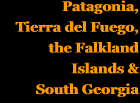 |
|||||||||||||
 |
|||||||||||||
 |
|||||||||||||
 |
|||||||||||||


Chapter 4
The FCE broad gauge network
Main pages
Bariloche line rolling stock •
Com. Rivadavia line extra photos •
Pto. Deseado line extra photos •
Pto. Deseado line extra photos 2 •
Appendices
2 Chronology of Patagonian railway proposals •
3 Bariloche line route itinerary •
4 Com. Rivadavia route itinerary •
5 Pto. Deseado route itinerary •
7 Com. Rivadavia line loco list •
8 Pto. Deseado line loco list •
15 FCP working timetable instructions 1960 •
16 Report on construction 1912 A •
17 Report on construction 1912 B •
21 President Alcorta address •
23 Purchase of wagons decree •
25 Early Patagonian proposals •
26 Progress to Bariloche 1926 •
28 Restructuring report 1953 •
Appendix 28
1953 Restructuring report
Ministry of Transport of the Nation.
Restructuring and Coordination of the Services of Transport in the Patagonian Territories.
Reports and Conclusion of the Special Committee created by Ministerial Resolution N° 515/53.
From its considerations, the said resolution issued as a result of the policies arising from the Second Quinquennial Plan, especially the wisdom of the promotion and development of under-populated regions, and in particular Patagonia, intensifying the working the natural resources of these zones and the development of appropriate regional industries, it is necessary to undertake the studies and adopt adequate means for extracting the maximum benefit of the transport potential in these regions and their later expansion.
It is advisable to approach in an independent way the study of the coordination and the restructuring of the transport services being attentive to the geo-economic characteristics of the territory, the basic structure of its ways of communication, the magnitude the un-worked natural resources and the importance that the Nation revisits the geo-economic reactivation of the Patagonian region.
The reports and conclusions are to be consigned, analysing the conditions in which production, distribution and consumption, are developed in Patagonia, so the populated centres follow the lines of the Atlantic coast, of the fertile longitudinal valleys of the pre-Cordillera and the transverse railways whose terminals do not achieve linkage with the pre-Cordillera, area, the rest is a great semi-desert of stepped plains with little water and poor vegetation dedicated to the raising of ovine livestock.
Referring to the principal Patagonian products, the report notes the “incomplete development of the lines of the Patagonic railways, which must be considered as a negative factor for a more regular, and greater volume of, mineral production”.
The Patagonic railways are of an incomplete route not extending to form a link between the ports to the pre-Cordillera zone – the concept that gave rise to their construction.”
The task of reorganizing and restructuring is divided into three stages which comprise a considerable expansion of the possibilities of transport, even exceeding the necessities of production in the first instance, including the road-railway-sea coordination through a special distribution of the traffic and reorganisation of the railway services.
The final stage defines the definitive construction of a Patagonic railway theme:
This stage will comprise the realization of the great breadth of the works in respect of rail-facilitated ports with the possible prolongation of the present lines to their natural terminals in the Cordillera and eventually the linking among some of them with the improvement of the present-day roads and the construction of airports, completing thus the present network of air services.”
The Ferrocarril Industrial Eva Perón ought, without detriment to its character, be integrated with the Patagonic network, opening it to public service.”
It is necessary also to face up to the construction of a new industrial railway to make feasible the working of the important iron mines at Sierra Grande.”
10-3-2018